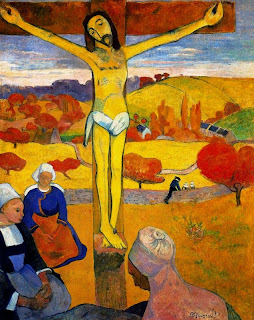Symbolism was primarily a French literary movement in the 1880's. Soon enough, the artists who were fed up with naturalism and realism transferred the movement over into the visual arts. It was a movement modestly trying to establish art as a representation of emotion or an idea rather than express the world in a 'quasi-scientific' and objective manner that was preferred by the realists and impressionists.
The symbolists were effectively a reaction against a reaction against a reaction and basically wanted to return art to a romantic-ish era whereby the artist can represent their own emotion. The term symbolism was not used in conjuction with art until 1891 when there was an article published on Gauguin - largely considered the father of the symbolists.
Gauguin was a good friend of Van Gogh. Gauguin became increasingly dissilussioned with the whole impressionist movement and this caused the two to have an argument. Eventually leading to Van Gogh cutting his earlobe off. The two never met again.
Paul Gauguin - the master of symbolism
The Yellow Christ, 1889
I'd never heard of Gauguin until I visited the Courtauld institute and saw the collection that they have. It really was one of the better collections I'd seen in general so if I'm gonna suggest anywhere arty for anyone to visit it would be here. I was first struck by how much this man must have influenced Picasso (my man) and the Primitive tendency in modern art. He apparently seldom left traces of what the colours symbolised in his paintings. Symbolic art can be identified by expressive rather than factual use of colour.
Where Do We Come From? What Are We? Where Are We Going? 1897
Paul Gauguin visited Tahiti and Hiva Oa Island regularly and from 1895 he moved there permanently. While away he had clearly been studying the forms of the foreign women, their way of life and 'primitive' sculpture. The title of this painting may suggest he felt as if he, or humanity itself, had lost it's identity in the industrial revolution. He was clearly entranced by unindustrialised, foreign culture. He said that he hated 'artificial' culture.
Arearea, 1891
Another example of expressive use of colour. This was painted during a visit to French Polynesia. He left feeling angered by France and French culture. I think therefore that the river flowing red may represent severred ties with France.
Paul Senisier - a follower of Gauguin
The Talisman, 1888
This is particularly important because it is an example of moving towards abstraction - and so early for it too. The symbolists and all the avant-garde alike saw little point in conventional art now that photography could pacify the need of mimesis.
Odilon Redon - an example of an older generation of artists who laid the basis of pictorial symbolism for Gauguin to develop.
The Eye Balloon , 1878
Buddha, 1891
The Birth of Venus, 1912
Symbolic of Venus being born out of a pearl of a shell.
Ophelia, 1905
Symbolic because (in opposition to the above) it does not literally depict the event but suggests what may be going on. It is extremely evocative. First thought that comes to mind is the water, as Ophelia fell from a tree and drowned. But what is bizarre is the fact that the water looks like it's too shallow to have her laying in it and suggests it may be a reflection of her.








No comments:
Post a Comment